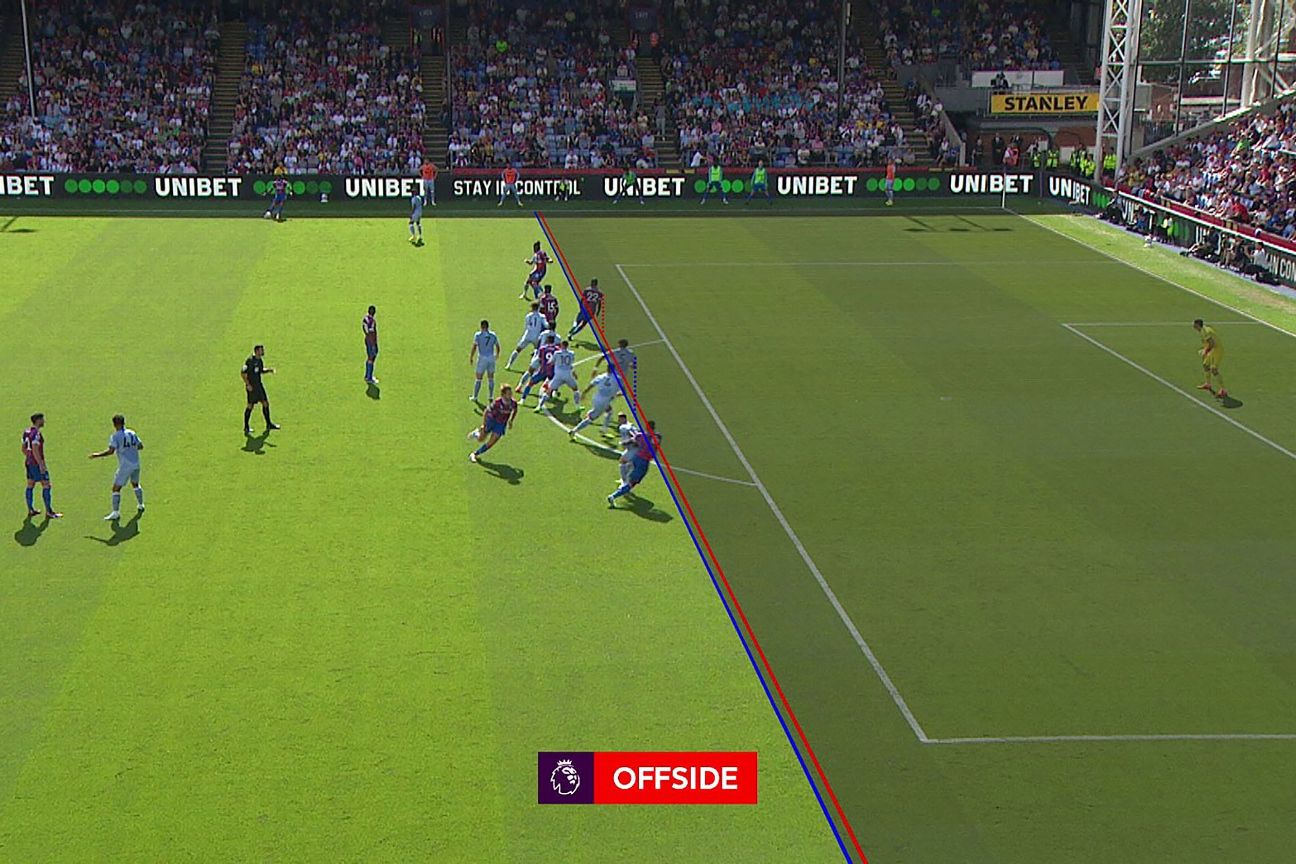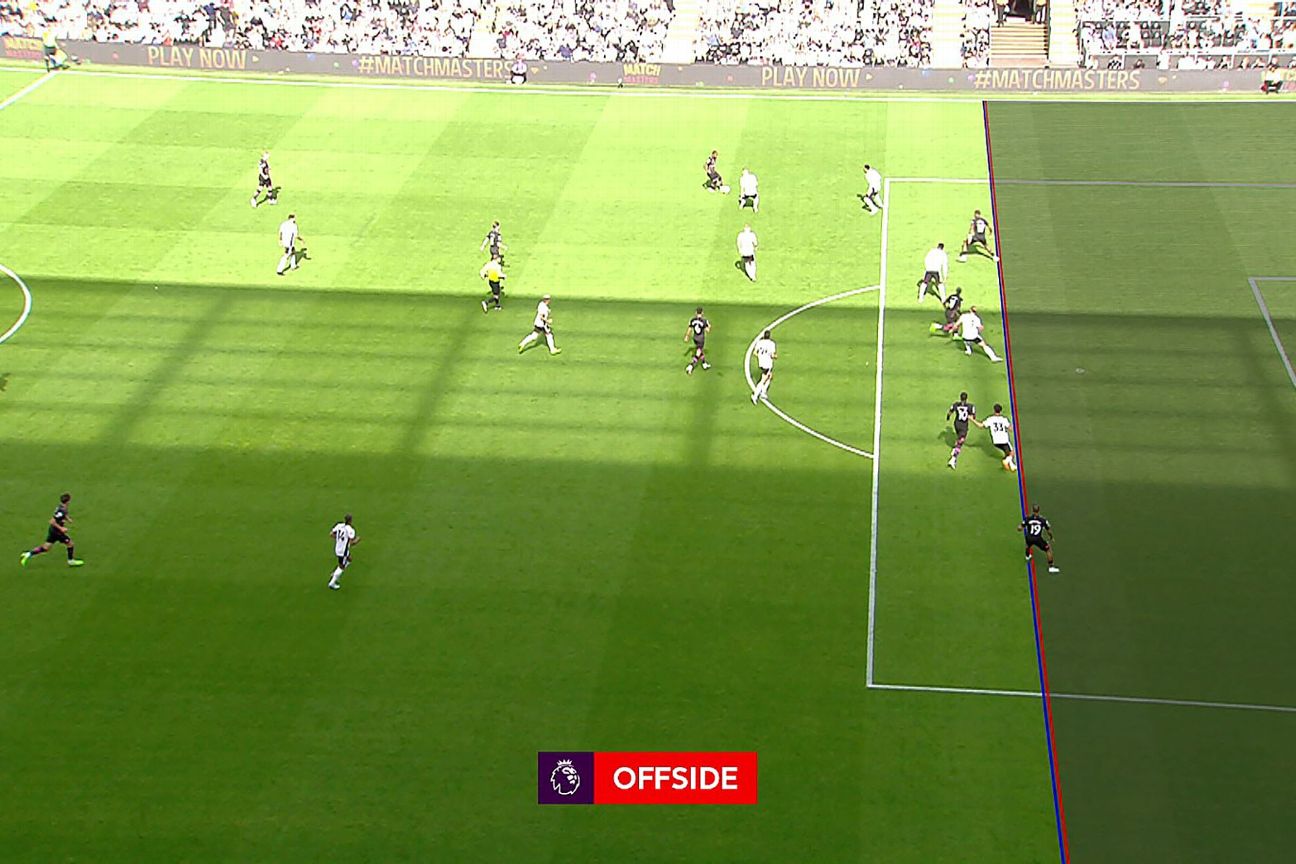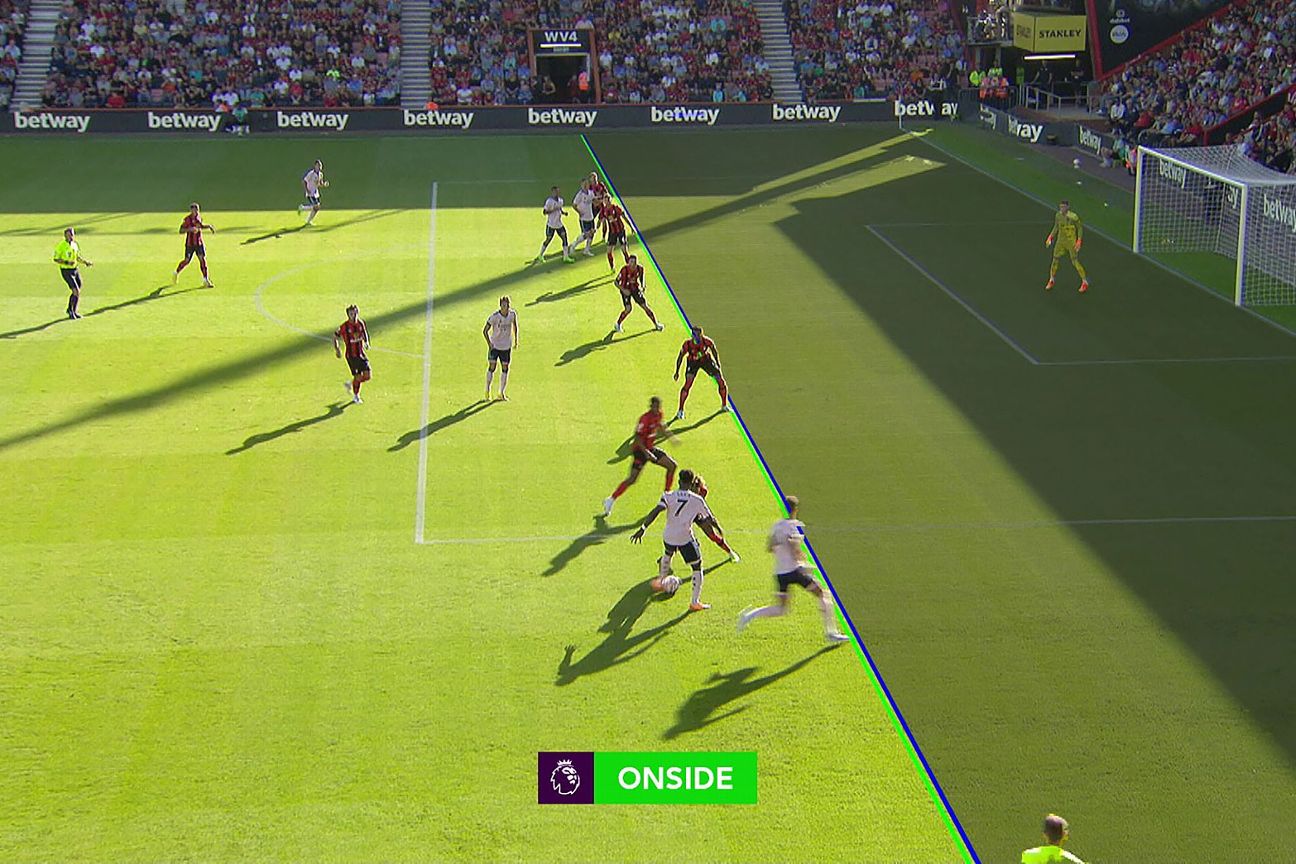Video Assistant Referee (VAR) causes controversy every week in the Premier League, but how are decisions made, and are they correct?
After each weekend, we take a look at the most high-profile incidents and examine the process both in terms of VAR protocol and the Laws of the Game.
- How VAR decisions affected every Prem club in 2022-23
- VAR's wildest moments: Alisson's two red cards in one game
- VAR in the Premier League: Ultimate guide
JUMP TO: Palace vs. Villa | Marginal offsides | West Ham vs. Brighton | Fulham vs. Brentford | Leicester vs. Southampton
Newcastle United 3-3 Manchester City
Overturned red card: Trippier foul on De Bruyne
What happened: With the score 3-3, Manchester City midfielder Kevin De Bruyne broke forward across the halfway line and was brought down by Newcastle United defender Kieran Trippier. Referee Jarred Gillett showed the red card.
VAR decision: The VAR, Peter Bankes, advised the card be downgraded to yellow.
VAR review: This decision might split some supporters, because there's no doubt the Trippier challenge was cynical and calculated, but a yellow card feels like the correct decision.
It does present a comparison with a similar VAR situation involving Newcastle last season, when the opposite happened as referee Craig Pawson booked Everton's Allan for a challenge on Allan Saint-Maximin and the VAR (Stuart Attwell) advised he should be sent off. The key difference between the challenges is the way Allan leads with his studs showing, which is always viewed more seriously.
It comes down to whether a referee judges the challenge to be serious foul play, and in particular if the offending player has endangered the safety of an opponent with excessive force or brutality. Ultimate consistency isn't possible with VAR, because whether a review goes to the monitor will come down to the subjective view of the video referee. This will always rely on an individual referee's interpretation; just as supporters will disagree about the nature of some challenges, so will officials. It's why two very similar situations can result in opposite outcomes.
The intervention to upgrade Allan's card to red was unnecessary, as the referee's original decision of a yellow card was a justifiable disciplinary outcome and wasn't a clear and obvious error. Everton's anger was compounded when their appeal against the midfielder's three-match ban was rejected by a Football Association panel. A challenge can be subjectively correct as a yellow card but also not subjectively incorrect as a red card -- which is why the appeal failed.
The first stage of a VAR review is for the referee to describe what he has seen, and the VAR then checks that against the replays. Gillett, who was on the blind side to the tackle, believed there had been studs-on-knee contact by Trippier, but the replays showed that wasn't the case and the foul was the top of the Newcastle defender's boot onto the bottom of De Bruyne's shin. That raises grounds for a pitchside review, though the VAR still has the right to uphold the red card based upon the nature of the challenge. In fact, many people will think that Trippier going into the challenge with both feet off the floor must mean he was out of control and the red card should have stood.
Everton fans will rightly be angry about the three-match ban for their player, as a yellow card is the best outcome in both cases.
VAR overturn: Goal allowed for Almiron after incorrect offside
What happened: Newcastle's Miguel Almiron made it 1-1 in the 28th minute, but the flag went up for offside.
VAR decision: Goal awarded.
VAR review: One quick look showed that Almiron wasn't offside from Saint-Maximin's initial ball into the box.
But there was a second check to judge if Joe Willock had touched the ball on its way though, which would have created a new phase and made Almiron offside ahead of the ball. But it was clear that Willock missed the ball, and there was no handball when scoring by Almiron, and the goal was correctly awarded.
Possible penalty: Foul by Stones on Schar
What happened: In the final moments of the first half, John Stones and Fabian Schar challenged for a high ball inside the area. No action was taken by Gillett.
VAR decision: No penalty.
VAR review: It's not a situation that is ever likely to be judged as a clear and obvious error by the VAR, with both players challenging for a high ball and with the referee having a clear view of the incident.
Would it have stayed as a penalty if awarded by referee Gillett? Most probably because Stones is more aggressive in the way he attacks the ball.
Crystal Palace 3-1 Aston Villa
VAR overturn: Penalty awarded for handball by Digne
What happened: It was 1-1 in the 55th minute when Marc Guehi's header was saved by Aston Villa goalkeeper Emiliano Martinez. The referee waved for play to continue as Palace defender Joachim Andersen appealed for handball against Lucas Digne.
VAR decision: Penalty awarded, missed but scored on the rebound by Wilfried Zaha.
VAR Review: It was a very harsh decision, as Digne was challenging for the ball and it hit his hand from close range.
The VAR, John Brooks, judged it filled the criteria for handball, with the arm above the shoulder, in an unnatural position and blocking an effort on goal. The law states "by having their hand/arm in such a position, the player takes a risk of their hand/arm being hit by the ball and being penalised."
Digne wasn't booked, but in Europe, it would be a mandatory yellow card for handball of an effort on goal (stopping a promising attack). The same doesn't seem to be applied in the Premier League.
By the letter of the law, Brooks wasn't wrong in advising a penalty, but we will see many similar situations where the VAR doesn't tell the referee there should be a penalty.
This differs from Southampton's claim at Leicester, when Joe Aribo's attempted cross hit the arm of Timothy Castagne -- but the defender clearly had his arm by his side when it was struck by the ball.
Offside: Why there will always be marginal decisions
This weekend saw a series of close offside calls, with three goals ruled out after VAR interventions.
- Why Rashford was onside, but Jesus and Toney offside
If a decision is so close, how can it really be given offside? No matter what technology you use, there will always be a marginal point upon which onside becomes offside -- it's inescapable. Even with the tolerance level (or margin for error) that was added to the VAR offside technology in the summer of 2021, there will always be situations that look incredibly tight.
The tolerance level means that if the two lines touch, onside will be given. If they don't, then it's offside. Pixelated images on social media give the impression that the lines are overlapping, but the high-definition images used by the VAR are much clearer.
Crystal Palace's Jeff Schlupp was the first to have a goal disallowed this weekend, for offside in the build-up against Odsonne Edouard. But in terms of VAR offside calls, this wasn't actually close with a clear gap between the lines.

But two other decisions were right on the margin. On Saturday, Ivan Toney's goal for Brentford was ruled out.

Then on Saturday evening it was Arsenal's Gabriel Jesus whose joy was short-lived when he was just in front of the last defender. This situation was even more marginal than Toney's -- so much so it's probably impossible for it to be closer without the technology marking it as within the tolerance level, and as such onside.

Arsenal had another offside situation on Martin Odegaard's second goal at Bournemouth, but Ben White was shown to be onside -- and he didn't even need the tolerance level for the goal to stand.

West Ham 0-2 Brighton
Penalty awarded: Kehrer fouls Welbeck
What happened: In the 20th minute, Brighton's Danny Welbeck broke into the area and was brought down by Thilo Kehrer. Referee Anthony Taylor gave the penalty.
VAR decision: Penalty stands; foul was inside the area.
VAR review: The check was for where the foul took place. The VAR will look for the contact point of the foul (which may not necessarily be the first contact.) VAR Lee Mason judged that the foul was just on the line, which belongs to the box and means a penalty would be the correct decision. It was an incredibly tight call.
The double jeopardy rule applies when a penalty is given and there has been a genuine attempt to play the ball, so Kehrer was booked. However, had the VAR decided that the foul on Welbeck had taken place outside the box, then a free kick would have been awarded and the card for the West Ham defender upgraded to a red.
Fulham 3-2 Brentford
Possible red card: Foul by Norgaard on Stansfield
What happened: Brentford's Christian Norgaard was late in a challenge on Jay Stansfield in the 14th minute. Referee Peter Bankes gave the free kick but took no disciplinary action.
VAR decision: No red card.
VAR review: As discussed in the first VAR Review of the season (see Scott McTominay's challenge on Moises Caicedo), we will see late tackles where a player catches his opponent above the ankle pretty much on a weekly basis. This doesn't mean they are all red cards.
Force and intensity in the challenge is important and the VAR, David Coote, correctly judged this wasn't present. The referee should have issued a yellow card, which the VAR is unable to advise.
Leicester 1-2 Southampton
Possible penalty: Foul by Kotchap on Vardy
What happened: In the second minute of the game, Jamie Vardy went down in the area under a challenge from Southampton's Armel Kotchap.
VAR decision: No penalty.
VAR review: This was a textbook example of a striker initiating contact to try to win a penalty. Vardy places his leg into the Southampton defender's to give the impression of a foul.
Even if referee Michael Salisbury had bought the foul and given the spot kick, there is little doubt that the VAR, Michael Oliver, would have advised an overturn.
Information provided by the Premier League and PGMOL was used in this story.
